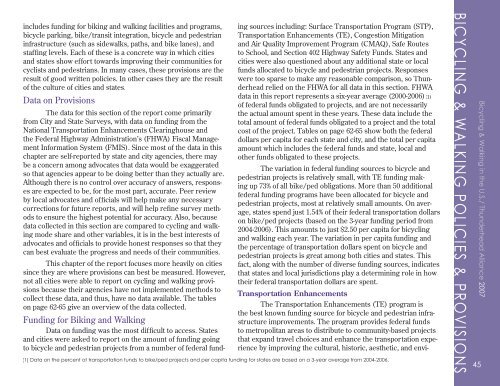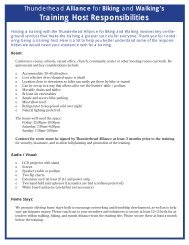2007 Benchmarking Report - Alliance for Biking & Walking
2007 Benchmarking Report - Alliance for Biking & Walking
2007 Benchmarking Report - Alliance for Biking & Walking
Create successful ePaper yourself
Turn your PDF publications into a flip-book with our unique Google optimized e-Paper software.
includes funding <strong>for</strong> biking and walking facilities and programs,<br />
bicycle parking, bike/transit integration, bicycle and pedestrian<br />
infrastructure (such as sidewalks, paths, and bike lanes), and<br />
staffing levels. Each of these is a concrete way in which cities<br />
and states show ef<strong>for</strong>t towards improving their communities <strong>for</strong><br />
cyclists and pedestrians. In many cases, these provisions are the<br />
result of good written policies. In other cases they are the result<br />
of the culture of cities and states.<br />
Data on Provisions<br />
The data <strong>for</strong> this section of the report come primarily<br />
from City and State Surveys, with data on funding from the<br />
National Transportation Enhancements Clearinghouse and<br />
the Federal Highway Administration’s (FHWA) Fiscal Management<br />
In<strong>for</strong>mation System (FMIS). Since most of the data in this<br />
chapter are self-reported by state and city agencies, there may<br />
be a concern among advocates that data would be exaggerated<br />
so that agencies appear to be doing better than they actually are.<br />
Although there is no control over accuracy of answers, responses<br />
are expected to be, <strong>for</strong> the most part, accurate. Peer review<br />
by local advocates and officials will help make any necessary<br />
corrections <strong>for</strong> future reports, and will help refine survey methods<br />
to ensure the highest potential <strong>for</strong> accuracy. Also, because<br />
data collected in this section are compared to cycling and walking<br />
mode share and other variables, it is in the best interests of<br />
advocates and officials to provide honest responses so that they<br />
can best evaluate the progress and needs of their communities.<br />
This chapter of the report focuses more heavily on cities<br />
since they are where provisions can best be measured. However,<br />
not all cities were able to report on cycling and walking provisions<br />
because their agencies have not implemented methods to<br />
collect these data, and thus, have no data available. The tables<br />
on page 62-65 give an overview of the data collected.<br />
Funding <strong>for</strong> <strong>Biking</strong> and <strong>Walking</strong><br />
Data on funding was the most difficult to access. States<br />
and cities were asked to report on the amount of funding going<br />
to bicycle and pedestrian projects from a number of federal funding<br />
sources including: Surface Transportation Program (STP),<br />
Transportation Enhancements (TE), Congestion Mitigation<br />
and Air Quality Improvement Program (CMAQ), Safe Routes<br />
to School, and Section 402 Highway Safety Funds. States and<br />
cities were also questioned about any additional state or local<br />
funds allocated to bicycle and pedestrian projects. Responses<br />
were too sparse to make any reasonable comparison, so Thunderhead<br />
relied on the FHWA <strong>for</strong> all data in this section. FHWA<br />
data in this report represents a six-year average (2000-2006)(1)<br />
of federal funds obligated to projects, and are not necessarily<br />
the actual amount spent in these years. These data include the<br />
total amount of federal funds obligated to a project and the total<br />
cost of the project. Tables on page 62-65 show both the federal<br />
dollars per capita <strong>for</strong> each state and city, and the total per capita<br />
amount which includes the federal funds and state, local and<br />
other funds obligated to these projects.<br />
The variation in federal funding sources to bicycle and<br />
pedestrian projects is relatively small, with TE funding making<br />
up 73% of all bike/ped obligations. More than 50 additional<br />
federal funding programs have been allocated <strong>for</strong> bicycle and<br />
pedestrian projects, most at relatively small amounts. On average,<br />
states spend just 1.54% of their federal transportation dollars<br />
on bike/ped projects (based on the 3-year funding period from<br />
2004-2006). This amounts to just $2.50 per capita <strong>for</strong> bicycling<br />
and walking each year. The variation in per capita funding and<br />
the percentage of transportation dollars spent on bicycle and<br />
pedestrian projects is great among both cities and states. This<br />
fact, along with the number of diverse funding sources, indicates<br />
that states and local jurisdictions play a determining role in how<br />
their federal transportation dollars are spent.<br />
Transportation Enhancements<br />
The Transportation Enhancements (TE) program is<br />
the best known funding source <strong>for</strong> bicycle and pedestrian infrastructure<br />
improvements. The program provides federal funds<br />
to metropolitan areas to distribute to community-based projects<br />
that expand travel choices and enhance the transportation experience<br />
by improving the cultural, historic, aesthetic, and envi-<br />
(1) Data on the percent of transportation funds to bike/ped projects and per capita funding <strong>for</strong> states are based on a 3-year average from 2004-2006.<br />
BICYCLING & WALKING POLICIES & PROVISIONS<br />
45<br />
Bicycling & <strong>Walking</strong> in the U.S./ Thunderhead <strong>Alliance</strong> <strong>2007</strong>



